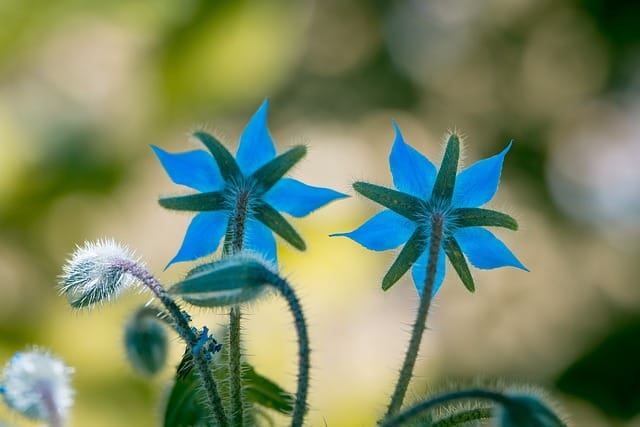How to grow Borage
Welcome to our guide on growing the borage herb! Whether you are an experienced gardener or a beginner, this article will provide you with all the information you need to successfully cultivate and utilize borage in your garden

In this article:
- Introduction
- What is Borage?
- Benefits and Uses
- Choosing the Right Variety
- Climate and Soil Requirements
- Planting Borage
- Watering and Fertilizing
- Managing Pests and Diseases
- Harvesting Borage
- Storing and Preserving
- Culinary Uses
- Medicinal Uses
- Borage in the Garden
- Companion Planting with Borage
- Frequently Asked Questions
- Conclusion
Introduction
Welcome to our guide on growing the borage herb! Whether you are an experienced gardener or a beginner, this article will provide you with all the information you need to successfully cultivate and utilize borage in your garden.
What is Borage?
Borage (Borago officinalis) is an annual herbaceous plant native to the Mediterranean region. It is known for its beautiful blue flowers and cucumber-like flavor. Borage has been used for centuries in culinary, medicinal, and gardening purposes.
Benefits and Uses
Borage offers numerous benefits and uses, making it a valuable addition to any garden. It attracts pollinators, repels pests, improves soil health, and offers culinary and medicinal properties. Some common uses include salads, teas, infused oils, and natural remedies.
Choosing the Right Variety
When selecting borage seeds or seedlings, consider the specific variety that suits your needs. The most common varieties are 'Blue Borage' and 'White Borage,' but there are also dwarf varieties and ones with pink flowers. Choose based on height, flower color, and preferred purposes.
Climate and Soil Requirements
Borage is adaptable to various climates but prefers moderate temperatures. It grows best in full sun to partial shade. The soil should be well-draining, fertile, and slightly acidic. If your soil is heavy or clayey, consider amending it with organic matter to improve drainage.
Planting Borage
Borage can be directly sown in the garden or started indoors and transplanted later. Sow seeds about 1/4 inch deep and space them 12 to 18 inches apart. Water gently after planting, and keep the soil consistently moist until germination occurs, usually within 7 to 14 days.
Watering and Fertilizing
Borage requires regular watering, especially during dry spells. Ensure the soil remains evenly moist but not waterlogged. Avoid overhead watering to prevent foliar diseases. Fertilize sparingly as borage doesn't have high nutrient requirements, but a balanced organic fertilizer can be applied once or twice during the growing season.
Managing Pests and Diseases
Borage is relatively pest and disease resistant. However, common pests like aphids, slugs, and snails might occasionally appear. Monitor your plants regularly and adopt organic pest control methods such as handpicking, companion planting, or using natural sprays to discourage these pests.
Harvesting Borage
Harvesting borage leaves, flowers, and stems can be done throughout the growing season. Early morning is the best time to harvest for maximum flavor and fragrance. Harvest individual leaves or cut entire stems, leaving a few leaves at the base to encourage regrowth. Always use sharp, clean tools when harvesting to avoid damage and contamination.
Storing and Preserving
To store borage leaves or flowers, gently wash them, pat them dry, and keep them in airtight containers in the refrigerator. They can stay fresh for up to a week. Borage can also be preserved by drying the leaves and flowers, which can be used later for teas, culinary purposes, or homemade beauty products.
Culinary Uses
Borage has a refreshing cucumber-like taste that makes it a favorite addition to salads, soups, and sandwiches. The flowers can be used in beverages, desserts, or as a decorative element in dishes. Borage leaves can be chopped and added to dips, sauces, or infused oils.
Medicinal Uses
Borage has various medicinal properties and has been used to alleviate respiratory issues, reduce inflammation, and promote healthy skin. Borage oil, extracted from its seeds, is rich in gamma-linolenic acid (GLA), an essential fatty acid with anti-inflammatory properties.
Borage in the Garden
Borage is a beneficial companion plant that attracts pollinators like bees and butterflies, enhancing the overall productivity of your garden. Its tall, beautiful flowers also serve as a backdrop for other plants and can add visual interest to your garden beds or borders.
Companion Planting with Borage
Planting borage alongside other herbs and vegetables can benefit their growth and health. Borage deters certain pests like tomato hornworms, cabbage worms, and Japanese beetles. It also attracts beneficial insects that prey on garden pests, making it an excellent companion for tomatoes, squash, peppers, and strawberries.
Frequently Asked Questions
Q: Can I grow borage indoors?
A: Borage can be grown indoors but requires sufficient light and space for optimal growth.
Q: Is borage safe for consumption?
A: Borage is generally safe when consumed in moderation but should not be ingested in large quantities.
Conclusion
Now that you have learned how to grow and utilize borage, it's time to start planting this versatile herb in your garden. Experiment with different culinary and medicinal uses, and enjoy the many benefits borage has to offer!
